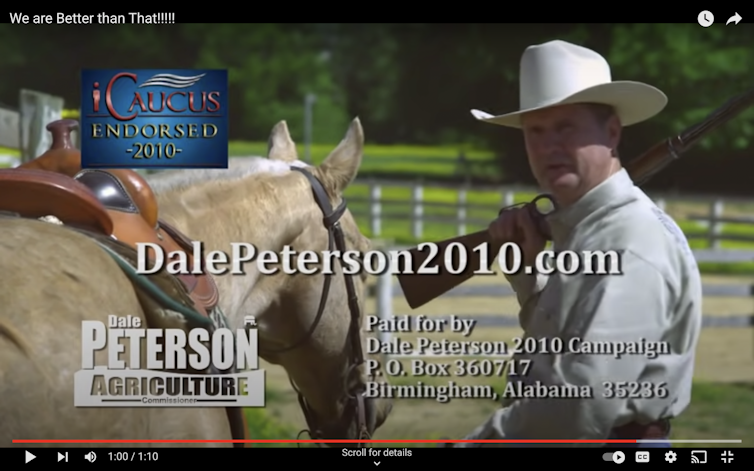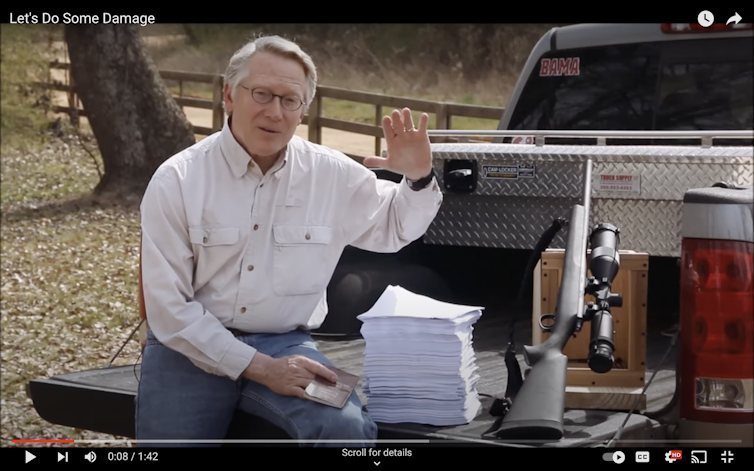Militant white identity politics in full form in GOP campaign ads featuring high-powered weapons
Republican Eric Greitens, a candidate for Missouri’s open U.S. Senate seat, shocked viewers with a new online political ad in June 2022 that encouraged his supporters to go “RINO hunting.”
Appearing with a shotgun and a smirk, Greitens leads the hunt for RINOs, shorthand for the derisive “Republicans In Name Only.” Along with armed soldiers, Greitens is storming a house under the cover of a smoke grenade.
“Join the MAGA crew,” Greitens says in the video. “Get a RINO hunting permit. There’s no bagging limit, no tagging limit and it doesn’t expire until we save our country.”
The ad comes from a candidate who has repeatedly found himself in controversy, having resigned as Missouri’s governor amid accusations of sexual assault and allegations of improper campaign financing that sparked an 18-month investigation that eventually cleared him of any legal wrongdoing.
The political ad was also launched – and quickly removed – from Facebook and flagged by Twitter at a time when the nation is still coming to terms with the insurrection at the U.S. Capitol and reeling from mass shootings in Tulsa, Oklahoma, Uvalde, Texas, Buffalo, New York and Highland Park, Illinois.
The ad continues to circulate on YouTube via various news sources.
Greitens’s call to political arms is hardly new.
In his 2016 gubernatorial ads, Greitens appeared firing a Gatling-style machine gun into the air and using an M4 rifle to create an explosion in a field to demonstrate his resistance to the Obama administration.
What Greitens’ ad represents, in our view, is the evolution of the use of guns in political ads as a coded appeal for white voters.
While they might have been a bit more ambiguous in the past, candidates are increasingly making these appeals appear more militant in their culture war against ideas and politicians they oppose.
Guns as a symbol of whiteness
As communication scholars, we have studied the ways that white masculinity has influenced contemporary conservative populism.
We have also examined the ways that racial appeals to white voters have evolved under the GOP’s Southern strategy, the long game that conservatives have played since the 1960s to weaken the Democratic Party in the South by exploiting racial animus.
In some of our latest work, we have examined the ways that guns have been used in campaign ads to represent white identity politics, or what political scientist Ashley Jardina has explained as the way that white racial solidarity and fears of marginalization have manifested in a political movement.
Symbolically, guns in the U.S. have historically been linked to defending the interests of white people.
In her book “Loaded: A Disarming History of the Second Amendment,” historian Roxanne Dunbar-Ortiz documents how America’s Founding Fathers originally conceived of the Second Amendment as protection for white frontier militias in their efforts to subdue and exterminate Indigenous people. The Second Amendment was also designed to safeguard Southern slave owners who feared revolts.
As a result, the right to bear arms was never imagined by the founders to be an individual liberty held by Indigenous people and people of color.
As illustrated in Richard Slotkin’s book “Gunfighter Nation: The Myth of the Frontier in Twentieth-Century America,” the popular film and literary genre of the Western glamorized white, hypermasculine cowboys and gunslingers “civilizing” the wild frontier to make it safe for white homesteaders.
Drawing from this lore, contemporary gun culture romanticizes the “good guy with a gun” as the patriotic protector of the peace and a bulwark against government overreach.
Contemporary gun laws reflect a historic racial disparity concerning who is authorized and under what circumstances individuals are allowed to use lethal force.
For example, so-called “stand your ground” laws have been used historically to justify the killing of Black men, most notably in the Trayvon Martin case.
Gun control advocates Everytown for Gun Safety have found that homicides resulting from white shooters killing Black victims are “deemed justifiable five times more frequently than when the shooter is Black and the victim is white.”
Militant white identity politics
Featuring a gun in a political ad has become an easy way to get attention, but our research has found that its meaning has shifted in recent years.
In a 2010 race for Alabama agriculture commissioner, Dale Peterson was featured in an ad holding a gun, wearing a cowboy hat and talking in a deep Southern drawl about the need to challenge the “thugs and criminals” in government.
His style proved entertaining.

In this 2010 political ad, Dale Peterson of Alabama appeared with a rifle on his shoulder.
Though Peterson placed third in his race, political analysts like Time magazine’s Dan Fletcher raved that he created one of the best campaign ads ever.
In the same year, Arizona Republican Pam Gorman ran for U.S. Congress.
She took the use of guns in political ads even further by appearing at a backyard range and firing a machine gun, pistol, AR-15 and a revolver in the same ad.
Though she gained attention for her provocative tactics, Gorman eventually lost to Ben Quayle, son of former Vice President Dan Quayle, in a 10-candidate primary.
Aside from the shock value, guns in ads became a symbol of opposition to the Obama administration.

In this 2014 political ad, Alabama congressional candidate Will Brooke used a high-powered rifle to shoot holes in Obamacare legislation.
For instance, in 2014, U.S. congressional candidate Will Brooke of Alabama ran an online ad in a Republican primary showing him loading a copy of the Obamacare legislation into a truck, driving it into the woods and shooting it with a handgun, rifle and assault rifle.
Not done, the remains of the copy were then thrown into a wood chipper. Although Brooke lost the seven-way primary, his ad received national attention.
The call to defend a conservative way of life got increasingly bizarre – and became a common tactic for GOP candidates.
Well before Greitens, U.S. congressional candidate Kay Daly from North Carolina fired a shotgun at the end of an ad during her unsuccessful campaign in 2015 asking supporters to join her in hunting RINOs.
The ad attacked her primary opponent, incumbent Rep. Renee Elmers, a Republican from North Carolina, for funding Obamacare, “Planned Butcherhood” and protecting rights of “illegal alien child molesters.”
Before he drew the ire of Trump, Brian Kemp climbed the polls in Georgia’s race for governor in 2018 with an ad titled “Jake” in which he interviewed his daughter’s boyfriend.
Holding a shotgun in his lap as he sat in a chair, Kemp portrayed himself as a conservative outsider ready to take a “chainsaw to government regulations” and demanding respect as his family’s patriarch.
The ads of the most recent cycle build on this development of the gun as a symbol of white resistance.

In this 2022 political ad, Marjorie Taylor Greene is wearing dark sunglasses and carrying a high-powered rifle.
Conservative GOP Rep. Marjorie Taylor Greene, from Georgia, ran an ad for a gun giveaway in 2021 that she made in response to what she claimed was Biden’s arming of Islamic terrorists as well as Speaker of the House Nancy Pelosi’s allegedly sneaking the Green New Deal and other liberal legislation into a budget proposal.
Firing a weapon from a truck, she announced she would “blow away the Democrats’ socialist agenda.”
The culture wars continue
Surrounding himself with soldiers, Greitens goes further than those before him in this latest iteration of the Republican use of guns.
But his strategy is not out of the ordinary for a party that has increasingly relied on provocative images of violent resistance to speak to white voters.
Despite the violence of Jan. 6, conservatives are still digging their own trenches.![]()
Ryan Neville-Shepard, Associate Professor of Communication, University of Arkansas and Casey Ryan Kelly, Professor of Communication Studies, University of Nebraska-Lincoln, University of Nebraska-Lincoln
This article is republished from The Conversation under a Creative Commons license. Read the original article.
- Disturbing ad featuring child with firearm comes back to haunt ... ›
- Arizona Republican Senate hopeful slammed as 'disgusting' for ... ›
- Watch: 'Make rifles great again': GOP candidate creates bizarre ... ›
